ENDER LILIES: Quietus of the Knights is a non-linear platformer set in a rainswept kingdom called Land’s End. I play as Lily, a girl sleeping in the ruins of a church. She is awoken by the Umbral Knight, a warrior’s spirit who wandered the kingdom as it was ravaged by the Blight, a sickness carried by rainfall that turns those it infects into undead monsters. In their life, the Umbral Knight swore an oath to protect the White Priestesses, girls with the power to purify Blight infections—and Lily may be the last one alive. Protected by the Umbral Knight, Lily sets out into the ruined Land’s End to discover and purify the Blight’s source before it can spread and destroy more kingdoms.
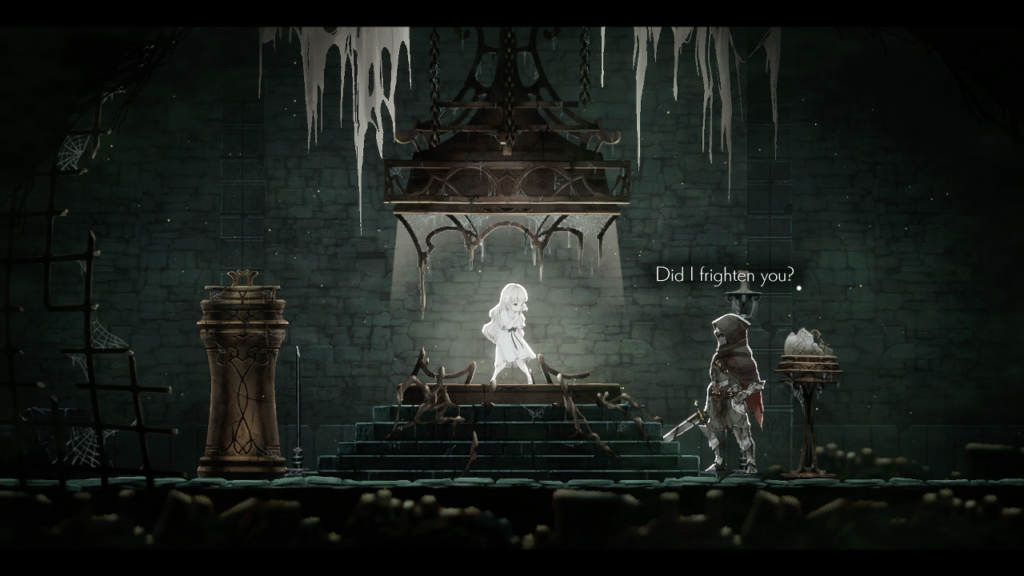
ENDER LILIES studiously follows the established non-linear platformer formula. I guide Lily through an open side-scrolling world. By platforming through rooms I can discover hidden collectables that increase Lily’s total hit points and other minor statistics. By fighting and defeating enemies, Lily accumulates experience levels that increase the amount of damage she can deal and absorb.
Often I discover paths which are beyond Lily’s ability to travel: A ledge just out of reach overhead, a tunnel filled with water, a shaft filled with colorful lanterns marking grapple points. I must return to these paths when I have earned new abilities from boss fights. A double jump lets Lily reach the ledge. A magic bubble lets her explore underwater. A grappling hook lets her climb up the shaft.
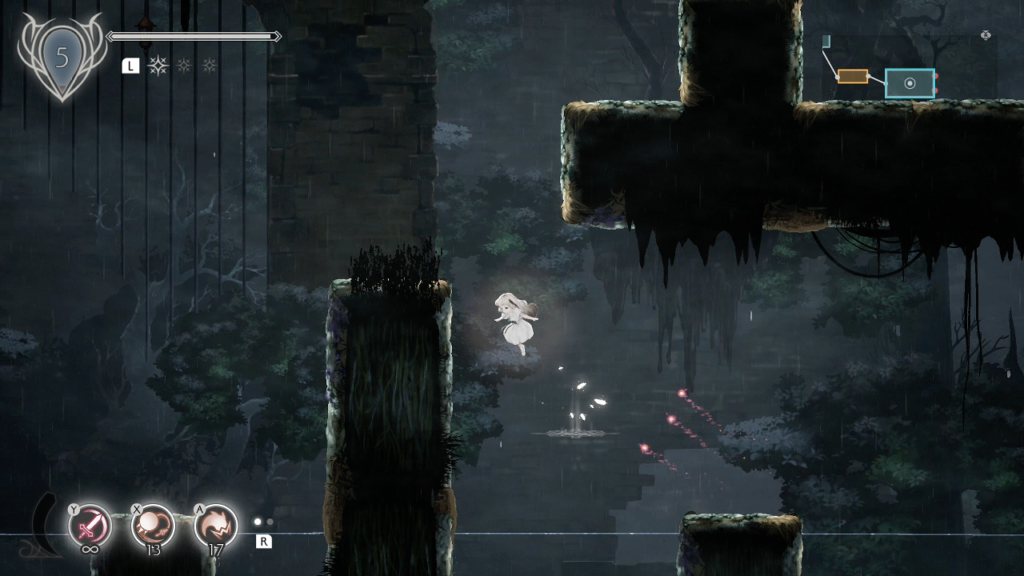
ENDER LILIES doesn’t try to break its mold, instead choosing to fill it competently, and I appreciate it for that even if I feel it could try a little harder to be original.
What keeps ENDER LILIES from being an also-ran among its many contemporaries is its player character. With white hair, white skin, a white dress, and a subtle white aura surrounding her body, Lily visually represents the purity which she spreads across the Blighted Land’s End. To further emphasize this role, Lily is also a pacifist player character. She can run, jump, and even dodge past enemies, but to actually fight back against Land’s End’s Blighted denizens she must rely on her spirit guardians.
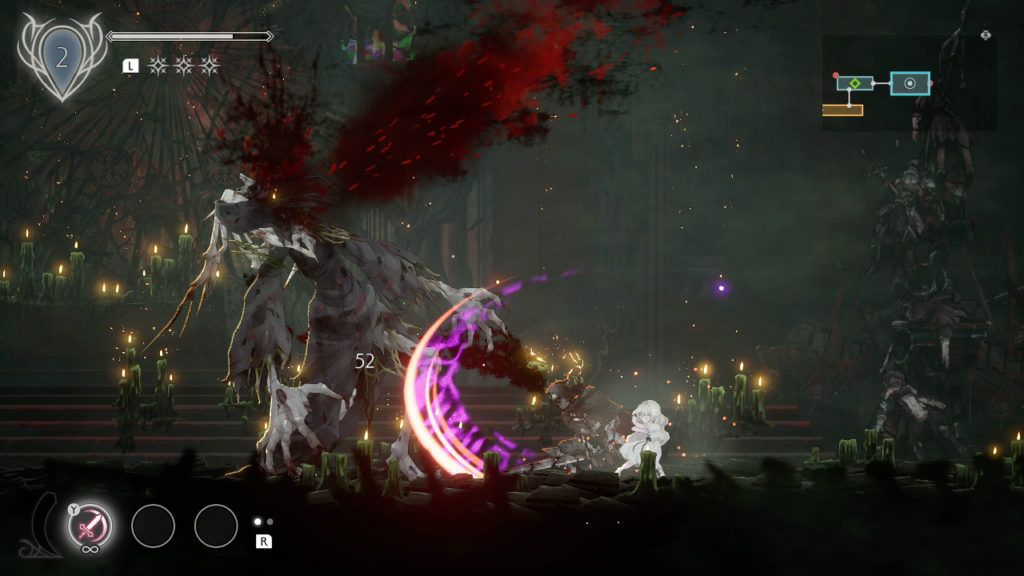
Lily begins equipped only with the Umbral Knight spirit. With the press of an attack button, the Knight appears to swing its sword at threats while Lily flinches away in fear. Shortly after her adventure begins, she defeats Guardian Siegrid in the first boss fight. By purifying Siegrid’s body, Lily acquires the Guardian’s spirit and can deploy her massive ball and chain in combat.
It’s not only bosses that can be absorbed in this way. Hidden across Land’s End are special fights with every standard enemy, all of which can be defeated to add their spirit to Lily’s repertoire. By the end of her adventure, Lily has an entire troop of specters protecting her from the Blighted monsters that hunt her.
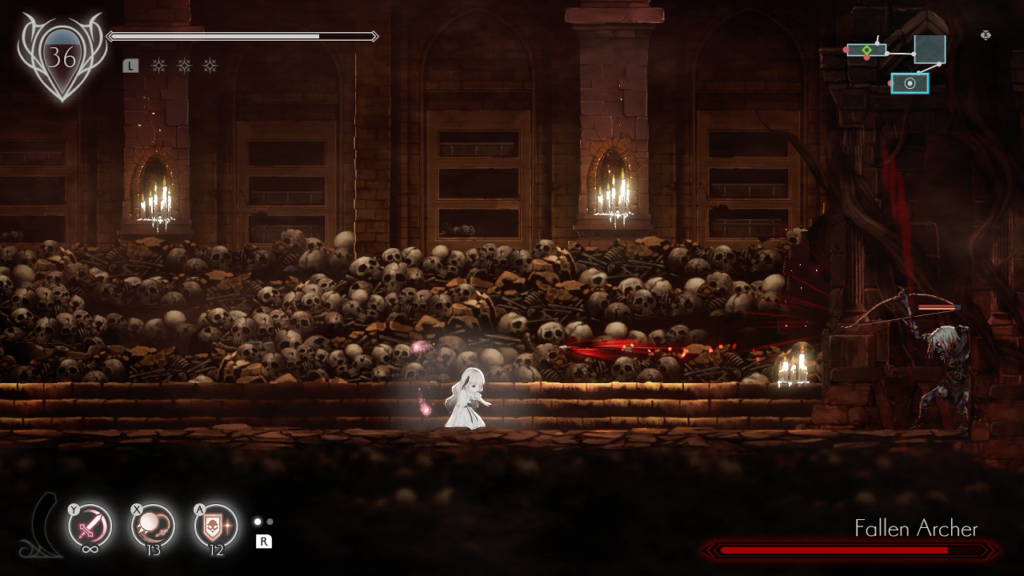
The spirits I choose to employ impact what strategies I use in combat. The Umbral Knight’s fast, weak strikes and Guardian Siegrid’s slow, strong ones form a strong melee backbone which I soon pair with the Headless Defender, a spirit that blocks a hit and responds with a devastating counterattack. Dark Witch Eleine’s spirit fires a three-pronged range attack, which I pair with the Western Merchant, a flying familiar that fires projectiles, and the Fallen Archer, which fires an arrow diagonally in front of Lily, to use when melee attacks are too dangerous. I can have two loadouts of three spirits equipped at a time, and with dozens of available spirits there are lots of interesting strategic combinations to explore.
I use these spirit loadouts in combat with the Blighted denizens of Land’s End. They put up a good fight, challenging me but not overwhelming me with sheer numbers or insurmountable advantages. The bosses aren’t much more of a threat—at first. Lily’s diving dodge, while not especially acrobatic, is surprisingly effective for positioning her behind bosses. This is sufficient to avoid most of their attacks. It’s the later bosses who really put me through my paces.
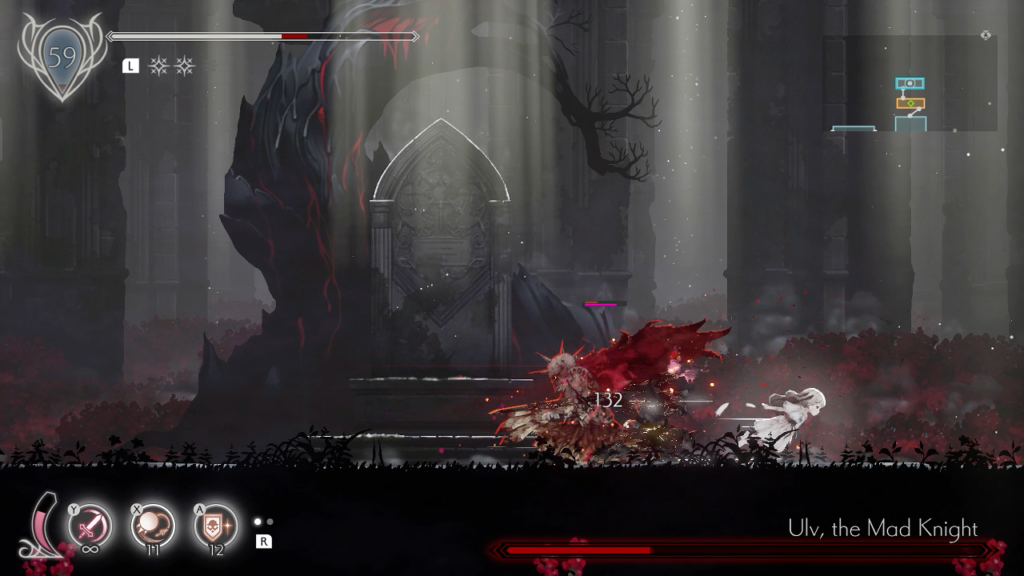
The challenging bosses begin with Ulv, the Mad Knight, a Blighted champion standing vigil over a grave in a field of red flowers. He attacks with ferocity, slamming the ground to fill the screen with damaging shockwaves, or else charging to swipe at Lily with rapid swings from his claws. The lower Ulv’s hit points, the faster he moves, until in his final breaths I have fractions of a second to react with a dodge or a counter. Defeating him was the first time I felt truly satisfied with ENDER LILIES’ combat.
It’s no accident that Ulv’s difficult encounter signposts the first ending, which is an especially unsatisfactory one. If I want to fully explore Land’s End and bring an end to the Blight I have to face many more bosses which demand increasing skill, strategy, and patience.
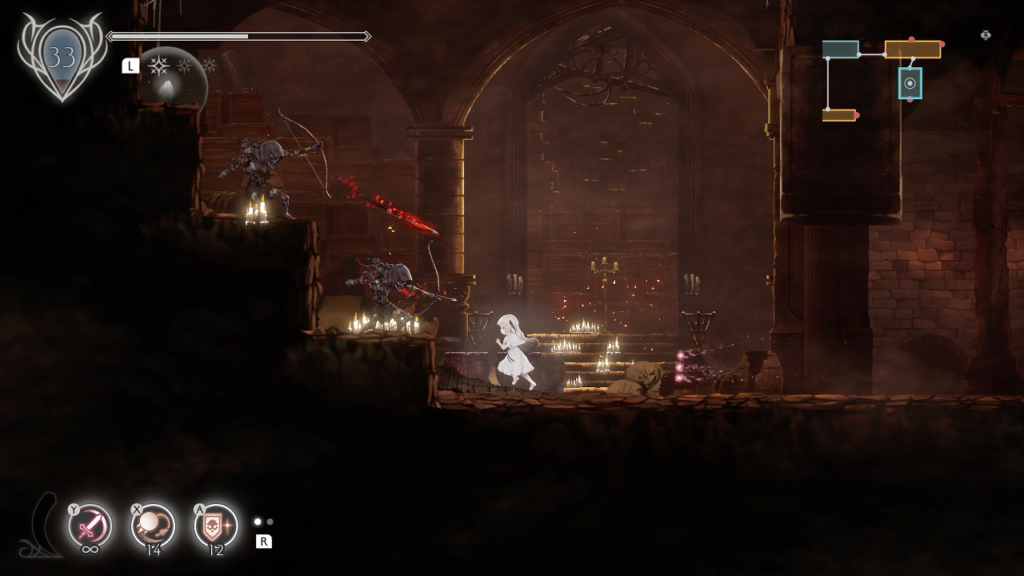
ENDER LILIES has a strong premise, environment, attack systems, and boss designs. Unfortunately I cannot say the same for its level design. As an environment built for adventure platforming, filled with branching paths, hidden nooks and crannies, and a variety of spaces to fight enemies in, it’s serviceable. As an artist’s craft, the level design is amateurish.
Rooms in ENDER LILIES are built from differently sized black squares. They are stretched and squashed and hollowed and multiplied, stacked above and below each other to create rooms, suspended in succession to create stairs and ledges. But every corner ends with a right angle, every pit with a sheer drop downwards. The squares are decorated with textures and objects to create a patina of distinct between areas, but strip away these flourishes and every room looks identical. It feels artificial, like every space in Land’s End was designed on graph paper then copied square-by-square into a level editor.
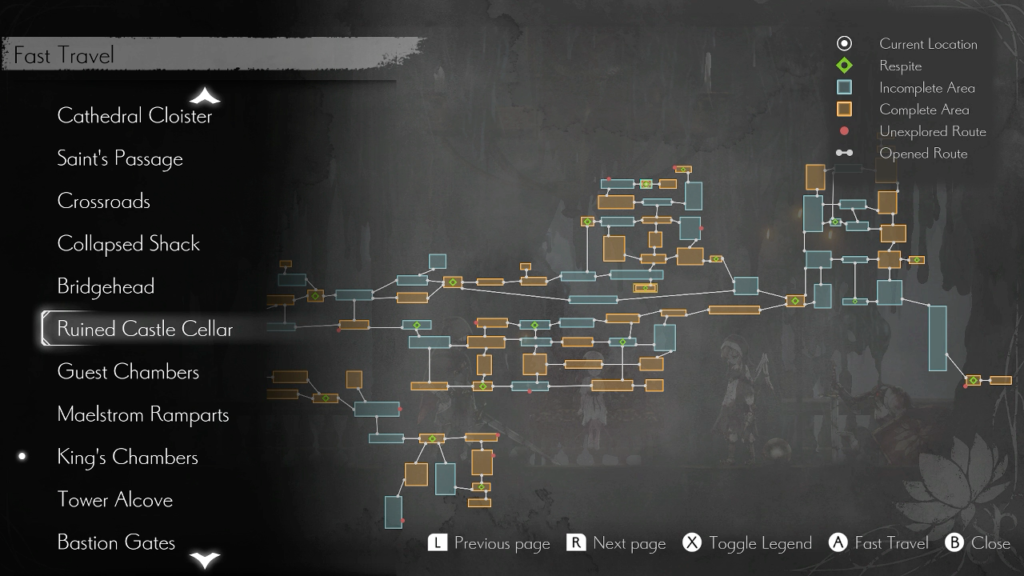
The next problem is how the map is constructed. Rooms do not connect directly to one another. Instead they hang in a void, the passages between them connected by long dotted lines that mark where I leave one room and enter another. Rooms that should be right next to each other appear far apart on the map. When I jump through an exit in a room’s ceiling, Lily is already standing on the floor in the room above it as though I have dawdled and she has been waiting for me to catch up. Land’s End’s many pieces do not feel like they fit together into a single whole. They feel like components in a labyrinth hastily strewn across a board and connected by rambling strings.
The result of the simple rooms and the abstracted map is Land’s End never feels like a cohesive place. It’s a digital space to be traversed and conquered, but not one to be inhabited in and understood. For all the dozens of hours I spend here, it never approaches an illusion of reality.
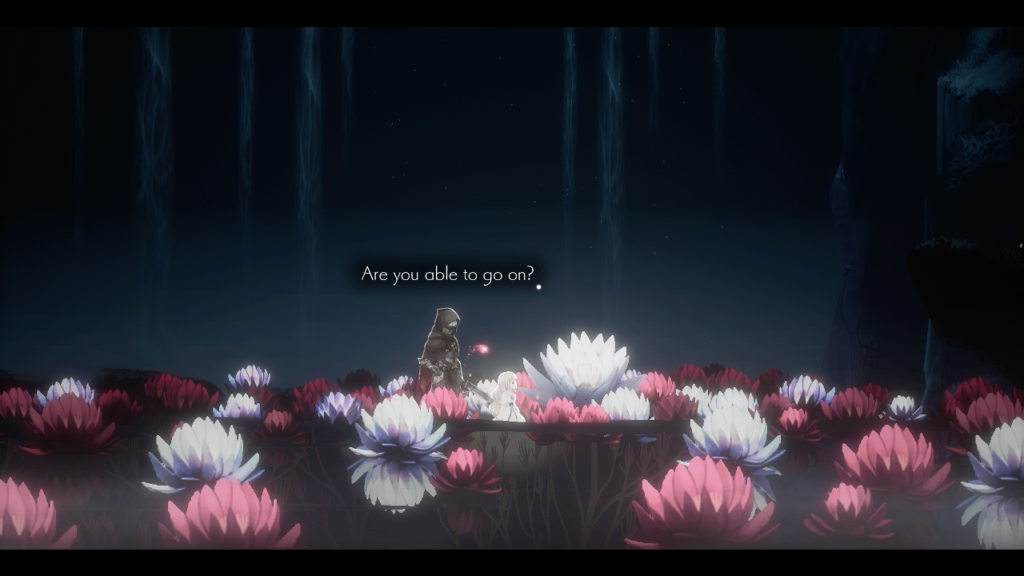
ENDER LILIES: Quietus of the Knights could easily have been an unremarkable, even generic, entry in the crowded indie non-linear platformer space. It is Lily’s pacifism that makes her stand out among the throng of bloodthirsty non-linear platformer protagonists. Equipping her with spirits which attack in her stead is a bit of a cheat. It gives me more to discover—an essential attribute of a good non-linear platformer—but it also makes Lily blend in more with her contemporaries. It makes me wonder if she really is any different from her peers who do not cower before the monsters they must overcome. Add onto this thematic uncertainty a rigid adherence to design dogma and uninteresting level design and ENDER LILIES ends up no more than a satisfactory addition to its milieu.